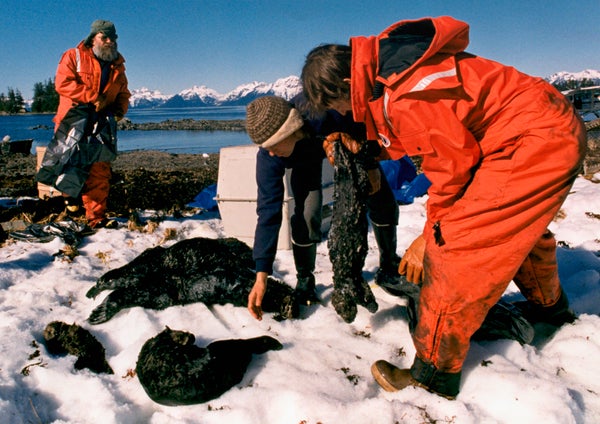This article was published in Scientific American’s former blog network and reflects the views of the author, not necessarily those of Scientific American
It took a quarter century, but the northern sea otters (Enhydra lutris kenyoni) living in Alaska's Prince William Sound have finally recovered from the effects of the 1989 Exxon Valdez oil spill, according to a new report from the U.S. Geological Survey (USGS).
The spill itself killed an estimated 40 percent of the 6,500 sea otters living in the sound, including 871 of the animals found dead in the days after the event. That was just the beginning, though. More dead adult otters were found in 1990 and 1991, and high juvenile death rates were seen through 1993, according to the Exxon Valdez Oil Spill Trustee Council. The council was created to oversee restoration of the Prince William Sound ecosystem and was funded by a $900-million civil court settlement after the disaster. The council blames the death rates and slow recovery on "chronic exposure to hydrocarbons" that persisted in the environment, especially in the otters' feeding grounds.
The USGS started conducing annual aerial surveys of sea otters in Prince William Sound in 1993. That year researchers counted 2,054 otters in the main part of the sound, another 335 on Montague Island and 75 on Knight Island, the latter of which experienced particularly heavy amounts of oil during the spill. Those numbers stayed fairly consistent for the next several years, but then the population fluctuated widely. In 1998 the main count jumped to 3,119 but crashed a year later to 2,475. Another, bigger crash was observed in 2002 (there was no count in 2001), when just 1,840 sea otters were identified. The population returned to health in 2008 and 2009, soaring to 3,958, but dropped by more than a thousand in 2011. Since then the numbers have risen nicely; the USGS reports that the main sea otter population in the sound was 4,277 last year, with 139 on Knight Island.
On supporting science journalism
If you're enjoying this article, consider supporting our award-winning journalism by subscribing. By purchasing a subscription you are helping to ensure the future of impactful stories about the discoveries and ideas shaping our world today.
Population numbers alone aren't the only factor considered in this recovery. USGS scientists tested otters for multiple genetic expressions that would indicate continued exposure to oil. Sea otters captured and tested in 2008 still showed high signs of these genetic expressions, but animals captured just four years later did not.
The scientists also examined dead otters. For several years the animals tended to die at younger ages than otters elsewhere, but today's mortality age rate matches that in other populations.
More than 20 different species were affected by the Valdez spill. "Although recovery time lines varied widely among species, our work shows that recovery of species vulnerable to long-term effects of oil spills can take decades," Brenda Ballachey, the study's lead author and a research biologist with the USGS, said in a press release. "For sea otters, we began to see signs of recovery in the years leading up to 2009, two decades after the spill, and the most recent results from 2011 to 2013 are consistent with recovery as defined by the Exxon Valdez Oil Spill Trustee Council."
Although this population of northern sea otters is now considered recovered, the subspecies as a whole—which can be found throughout Alaska's southern coast and islands—remains endangered, protected under the U.S. Endangered Species Act. They are a different subspecies than the sea otters that swim off California's coast.
The Exxon Valdez released an estimated 10.8 million gallons of crude oil when it ran aground on March 24, 1989. Although its environmental impact remains infamous, it was not a relatively large spill. By comparison, the 2010 Deepwater Horizon oil spill released an estimated 210 million gallons of crude oil into the Gulf of Mexico.
Related: Scientific American has numerous articles on the Exxon Valdez spill and its aftereffects in its archive
